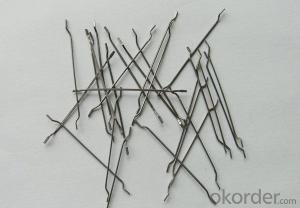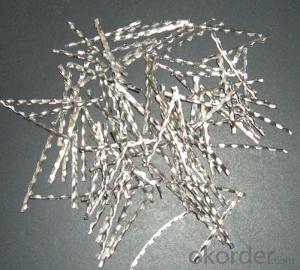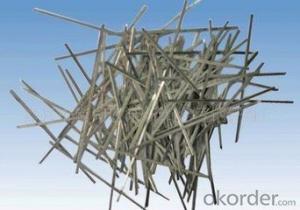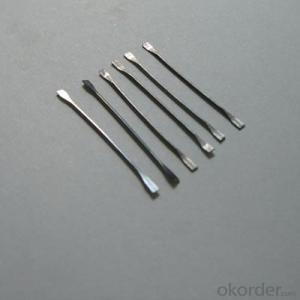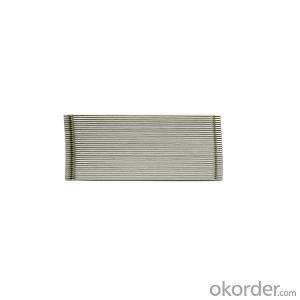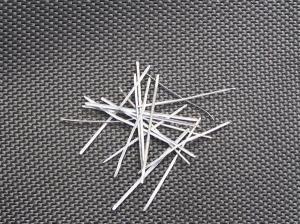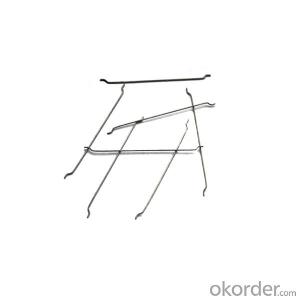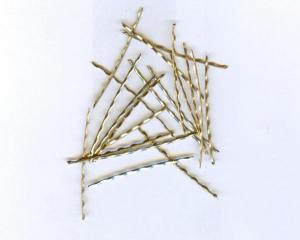Steel Fiber Copper Coated Hooked Ends From China
- Loading Port:
- Tianjin
- Payment Terms:
- TT OR LC
- Min Order Qty:
- 1000 kg
- Supply Capability:
- 30000 kg/month
OKorder Service Pledge
OKorder Financial Service
You Might Also Like
Quick Details
Place of Origin: Jiangsu, China (Mainland)
Model Number: HT-ST
Material: Steel
Specifications
(1) greatly improve concrete bonding and tensile strength
(2) improve mechanical performance concrete
(3) prevent the damage to the concrete
(4) decrease the danger from crack of the concrete
(5) provide exceptional load stability and durability
Uses
Steel fiber concrete has already been used for and wide on to many fields,such as road,bridge ,airport runway,tunnel ,culvert,hydro-power project,inner lining of underground construction.Port and pier,ocean project,nuclear test base rocket launch site,anti-earthquake building,ect
Picture
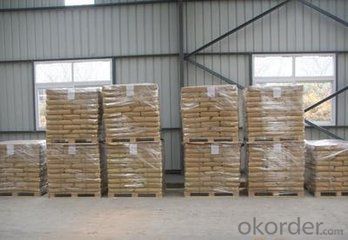
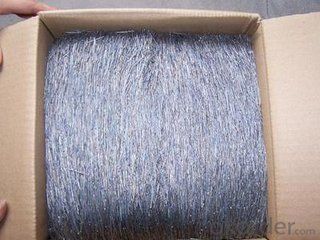

Steel fiber
FAQ
1. Directadding steel fibers to the belt,the rows of steel fiber as a whole,each of the concrete uniformly dispersed Corner
2. A water-soluble glue starts to dissolve,in a row of steel fibers in a dispersion premise,dispersed again in every corner of the monofilament fiber,showing a perspective view in the concrete of the fiber web, which play the role of an overall reinforcement.
3. Compare to the monofilament fiber,the glued steel fiber wouldn't be tied up,to ensure that the fibers in the concrete mixing does not agglomerate,distributed evenly.
- Q:What is the optimal fiber volume fraction for melt extract stainless steel fiber in concrete?
- The ideal fiber volume fraction for melt extract stainless steel fiber in concrete may vary depending on the particular application and requirements. However, it is generally recommended to use a fiber volume fraction ranging from 0.5% to 2%. Using lower fiber volume fractions, such as 0.5% to 1%, can enhance crack resistance and improve resistance against shrinkage and plastic settlement. These fibers effectively distribute and regulate cracks in the concrete, reducing the risk of crack propagation and enhancing the overall durability and performance of the concrete. On the contrary, higher fiber volume fractions, approximately 1.5% to 2%, can be advantageous in applications that demand higher tensile and flexural strength, such as industrial flooring or structures exposed to heavy loads and high impact forces. The increased fiber content reinforces the concrete matrix and improves its ability to withstand these types of stresses. It should be emphasized that the optimal fiber volume fraction for melt extract stainless steel fiber in concrete must be determined based on the specific project requirements, taking into account factors like the desired level of crack control, load conditions, and the properties of the concrete mix. Seeking advice from a structural engineer or concrete expert can assist in determining the most suitable fiber volume fraction for a given application.
- Q:What is the effect of melt extract stainless steel fiber on the durability of tunnel linings?
- The use of melt extract stainless steel fiber in tunnel linings has a significant impact on their durability. Stainless steel fibers are known for their high tensile strength, corrosion resistance, and thermal stability, making them an ideal choice for reinforcing tunnel structures. One of the main effects of melt extract stainless steel fiber is its ability to enhance the crack resistance of the tunnel linings. When tunnels are subjected to various loads and stresses, such as ground movement or heavy traffic, they are prone to developing cracks. However, the addition of stainless steel fibers helps to distribute the load more evenly, thereby reducing the formation and propagation of cracks. This improvement in crack resistance ultimately enhances the durability of the tunnel linings. Furthermore, melt extract stainless steel fiber also improves the overall strength and stability of tunnel linings. The fibers reinforce the concrete matrix, providing additional strength and preventing the formation of weak points. This increased strength can help the tunnel linings withstand external forces and pressure, such as water infiltration or ground settlement, thereby prolonging their lifespan. Additionally, stainless steel fibers exhibit excellent resistance to corrosion, ensuring the long-term durability of tunnel linings. Tunnels are often exposed to harsh environmental conditions, including moisture, chemicals, and temperature variations, which can accelerate the degradation of traditional reinforcement materials. However, stainless steel fibers are highly resistant to corrosion, making them a reliable choice for enhancing the durability of tunnel linings. Overall, the effect of melt extract stainless steel fiber on the durability of tunnel linings is significant. It improves crack resistance, enhances strength and stability, and provides excellent corrosion resistance. By incorporating these fibers into tunnel construction, engineers can significantly increase the lifespan and reliability of tunnel linings, ensuring their long-term durability.
- Q:Can melt extract stainless steel fiber be used in airport runways?
- Airport runways can indeed utilize melt extract stainless steel fiber. These fibers boast remarkable durability and possess impressive tensile strength, rendering them suitable for enduring heavy traffic loads, including aircraft arrivals and departures. Moreover, stainless steel fibers exhibit resistance to corrosion and can withstand harsh weather conditions, a vital attribute for runways exposed to diverse elements. Furthermore, incorporating stainless steel fibers in airport runways can enhance their overall performance and lifespan, thereby reducing the necessity for frequent repairs and maintenance.
- Q:How does melt extract stainless steel fiber affect the workability of shotcrete?
- Melt extract stainless steel fiber improves the workability of shotcrete by enhancing its cohesion and reducing the occurrence of segregation. The fibers act as reinforcement, increasing the tensile strength and ductility of the shotcrete, thereby reducing the risk of cracking and improving its overall performance.
- Q:What is melt extract stainless steel fiber?
- Melt extract stainless steel fiber refers to a high-performance reinforcing fiber that is made from stainless steel through a process called melt extraction. During this process, the stainless steel is melted and then rapidly solidified to form fine, continuous fibers. These fibers are typically used as a reinforcement material in various applications, such as concrete and refractory materials. They are known for their exceptional strength, durability, and resistance to corrosion, making them an ideal choice for demanding environments. The use of melt extract stainless steel fibers in concrete improves its mechanical properties, including flexural strength, impact resistance, and crack resistance. This reinforcement enhances the overall performance and longevity of concrete structures, particularly in applications where high strength and durability are required, such as industrial flooring, tunnel linings, and bridge decks. In refractory materials, melt extract stainless steel fibers are used to enhance the thermal shock resistance and mechanical strength of the material. These fibers can withstand extreme temperatures, making them suitable for applications in furnaces, kilns, and other high-temperature environments. Overall, melt extract stainless steel fibers offer a versatile and reliable solution for reinforcing various materials, providing increased strength, durability, and resistance to corrosion and thermal shock.
- Q:Can melt extract stainless steel fiber enhance the resistance of concrete to acid attack?
- Yes, melt extract stainless steel fiber can enhance the resistance of concrete to acid attack. Stainless steel fibers are known for their high corrosion resistance and durability. When added to concrete, they form a network that improves the strength and performance of the material. In the case of acid attack, concrete is prone to deterioration and damage. Acids can react with the calcium hydroxide in the cement paste, leading to the dissolution of the concrete matrix and a decrease in its strength. However, when stainless steel fibers are incorporated into the concrete mix, they create a barrier that prevents the acid from directly contacting the cement paste. The stainless steel fibers act as a reinforcement, enhancing the mechanical properties of the concrete. They provide additional strength and toughness, making the concrete more resistant to acid attack. The fibers also help in distributing the stress and reducing crack formation, further protecting the concrete from acid penetration. Additionally, the corrosion resistance of stainless steel fibers ensures that they remain intact even in aggressive environments. This means that they can continue to provide reinforcement and protection to the concrete for an extended period. Overall, melt extract stainless steel fiber can significantly enhance the resistance of concrete to acid attack by reinforcing the material, preventing direct contact between acids and the cement paste, and improving the durability of the concrete.
- Q:What is the effect of melt extract stainless steel fiber on the post-cracking behavior of concrete?
- The effect of melt extract stainless steel fiber on the post-cracking behavior of concrete is significant. When stainless steel fibers are added to concrete, they act as reinforcement and enhance the tensile strength and ductility of the material. This reinforcement helps to control cracking in the concrete and improve its performance under various loading conditions. The addition of melt extract stainless steel fibers in concrete increases its ability to resist cracking and reduces the chances of brittle failure. These fibers are typically thin and long, which allows them to distribute stress more evenly throughout the concrete matrix. As a result, the concrete can withstand higher tensile and flexural stresses without developing significant cracks. Moreover, the use of stainless steel fibers improves the post-cracking behavior of concrete by reducing crack widths and increasing crack resistance. This is particularly beneficial in structures subjected to dynamic or cyclic loading, such as bridges or pavements. The steel fibers help to limit crack propagation and prevent the formation of wide cracks, which can compromise the structural integrity and durability of the concrete. Additionally, melt extract stainless steel fibers can also enhance the durability of concrete by reducing the risk of corrosion. Stainless steel is highly resistant to corrosion, even in aggressive environments, making it an ideal reinforcement material for concrete exposed to moisture, chloride ions, or other corrosive substances. This resistance to corrosion ensures the long-term performance and service life of the concrete. In summary, the addition of melt extract stainless steel fiber to concrete has a positive effect on its post-cracking behavior. It improves the tensile strength, ductility, crack resistance, and durability of the material. These benefits make stainless steel fibers an excellent choice for reinforcing concrete structures, enhancing their overall performance and longevity.
- Q:How does melt extract stainless steel fiber enhance the toughness of concrete?
- Melt extract stainless steel fiber is a type of reinforcement material used in concrete that significantly enhances its toughness. The process of melt extraction involves melting stainless steel and then rapidly cooling it to create thin, elongated fibers. When these stainless steel fibers are added to concrete, they provide various mechanisms to enhance its toughness. Firstly, they act as micro-reinforcements, dispersing throughout the concrete matrix and creating a three-dimensional network. This network helps to distribute loads more evenly, preventing crack propagation and improving the overall strength and durability of the concrete. Additionally, the high tensile strength of stainless steel fibers allows them to bridge cracks that may occur in the concrete. This bridging effect helps to maintain the integrity of the structure by preventing cracks from widening or propagating further. As a result, the concrete becomes more resistant to impact, cyclic loading, and other forms of mechanical stress. Moreover, the presence of stainless steel fibers in concrete can also improve its resistance to shrinkage and cracking during the curing process. The fibers act as reinforcement against the tensile forces that develop as the concrete undergoes drying and shrinkage. This reduces the likelihood of cracks forming, further enhancing the toughness and durability of the concrete. In summary, melt extract stainless steel fiber enhances the toughness of concrete by creating a three-dimensional network, bridging cracks, and improving resistance to shrinkage and cracking. By incorporating stainless steel fibers into concrete, the overall strength, durability, and structural integrity of the concrete are significantly improved, making it a preferred choice for applications that require high-performance concrete.
- Q:Does melt extract stainless steel fiber improve the resistance to sulfate attack of shotcrete?
- The resistance to sulfate attack of shotcrete can be improved by using melt extract stainless steel fiber. When sulfates from the environment penetrate the concrete and react with the calcium hydroxide in the cement paste, sulfate attack occurs. This reaction results in the formation of expansive products, which can lead to cracking and deterioration of the concrete. Shotcrete, a type of concrete that is sprayed onto surfaces, is particularly vulnerable to sulfate attack due to its higher water-cement ratio and reduced curing time. To enhance the mechanical properties and durability of shotcrete, melt extract stainless steel fiber is added as reinforcement. The inclusion of stainless steel fibers in shotcrete significantly enhances its resistance to sulfate attack. Stainless steel fibers possess high tensile strength and excellent corrosion resistance, making them suitable for use in aggressive environments with high sulfate concentrations. These fibers act as reinforcement in the shotcrete, reducing the likelihood of cracking and providing improved resistance to sulfate attack. Furthermore, melt extract stainless steel fibers have a unique microstructure that promotes bonding with the cement matrix, resulting in enhanced performance of the shotcrete. The interaction between the stainless steel fibers and the cementitious matrix creates a stronger and more durable material that can withstand the detrimental effects of sulfate attack. In conclusion, the addition of melt extract stainless steel fiber to shotcrete enhances its resistance to sulfate attack. The high tensile strength, corrosion resistance, and bonding properties of stainless steel fibers contribute to the overall durability and longevity of shotcrete in environments rich in sulfates.
- Q:How does melt extract stainless steel fiber contribute to the ductility of concrete?
- There are several ways in which melt extract stainless steel fibers contribute to the ductility of concrete. Firstly, the addition of these fibers in small proportions enhances the overall flexural and tensile strength of the concrete, making it more ductile and capable of withstanding greater loads without cracking. Secondly, the unique properties of stainless steel, such as its high tensile strength and corrosion resistance, make it an ideal material for reinforcing concrete. When added as fibers, stainless steel provides additional reinforcement throughout the concrete, increasing its toughness and ductility. Moreover, the randomly dispersed stainless steel fibers act as micro-crack arresters, preventing cracks from propagating and improving the concrete's behavior after cracking. This means that even if cracks occur, they are less likely to spread and cause catastrophic failure. Additionally, the melt extract stainless steel fibers improve the bond between the concrete and the fibers themselves. This enhanced bond allows for more effective transfer of loads between the fibers and the surrounding concrete, further enhancing the material's ductility. In conclusion, melt extract stainless steel fibers contribute to the ductility of concrete by improving its flexural and tensile strength, enhancing crack resistance, and improving the bond between the fibers and the concrete. As a result, the concrete becomes more durable and resilient, capable of withstanding greater loads and deformation without failure.
1. Manufacturer Overview |
|
|---|---|
| Location | |
| Year Established | |
| Annual Output Value | |
| Main Markets | |
| Company Certifications | |
2. Manufacturer Certificates |
|
|---|---|
| a) Certification Name | |
| Range | |
| Reference | |
| Validity Period | |
3. Manufacturer Capability |
|
|---|---|
| a)Trade Capacity | |
| Nearest Port | |
| Export Percentage | |
| No.of Employees in Trade Department | |
| Language Spoken: | |
| b)Factory Information | |
| Factory Size: | |
| No. of Production Lines | |
| Contract Manufacturing | |
| Product Price Range | |
Send your message to us
Steel Fiber Copper Coated Hooked Ends From China
- Loading Port:
- Tianjin
- Payment Terms:
- TT OR LC
- Min Order Qty:
- 1000 kg
- Supply Capability:
- 30000 kg/month
OKorder Service Pledge
OKorder Financial Service
Similar products
New products
Hot products
Related keywords
